
Lessoniopsis littoralis
Strap Kelp
17 May 2022
Botany Bay, Juan de Fuca Strait, B.C., Canada.
Tide: 0.3 feet at 08:48 PDT (measured at Port Renfrew Tidal Station)
Conditions: Mix of sun and cloud, wind variable 5 to 10 km/hour, sea rippled, moderate westerly swell, humidity 70%, 9˚C.
Moon: Waning Gibbous (96.1%, 17 days); Previous Phase, Full Moon, 15 May 2022 at 9:14pm PDT: Next Phase, Third Quarter, 22 May 2022 at 11:43am PDT.
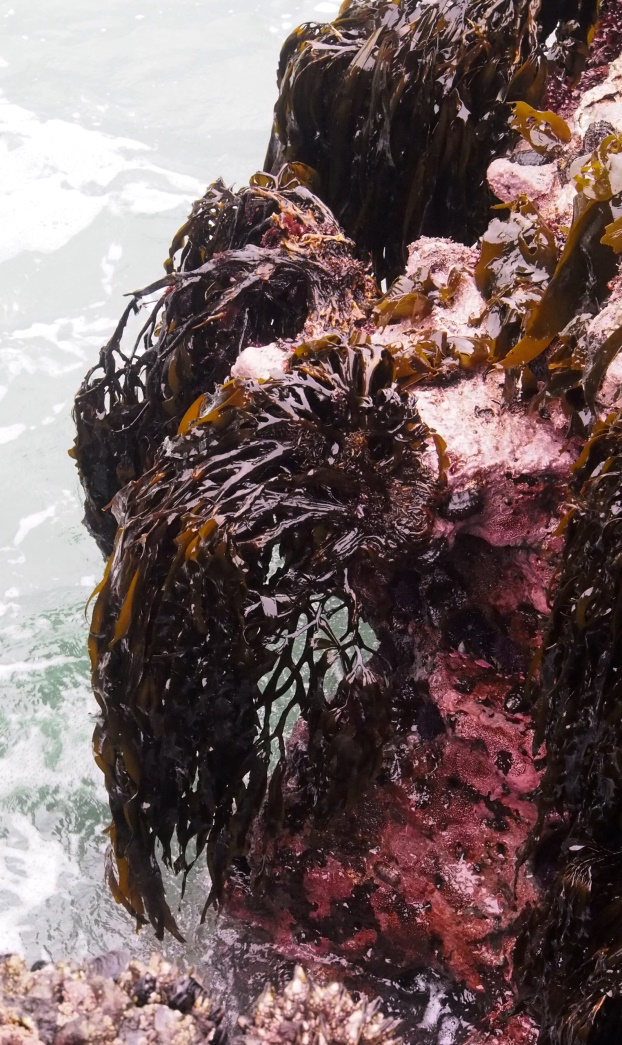
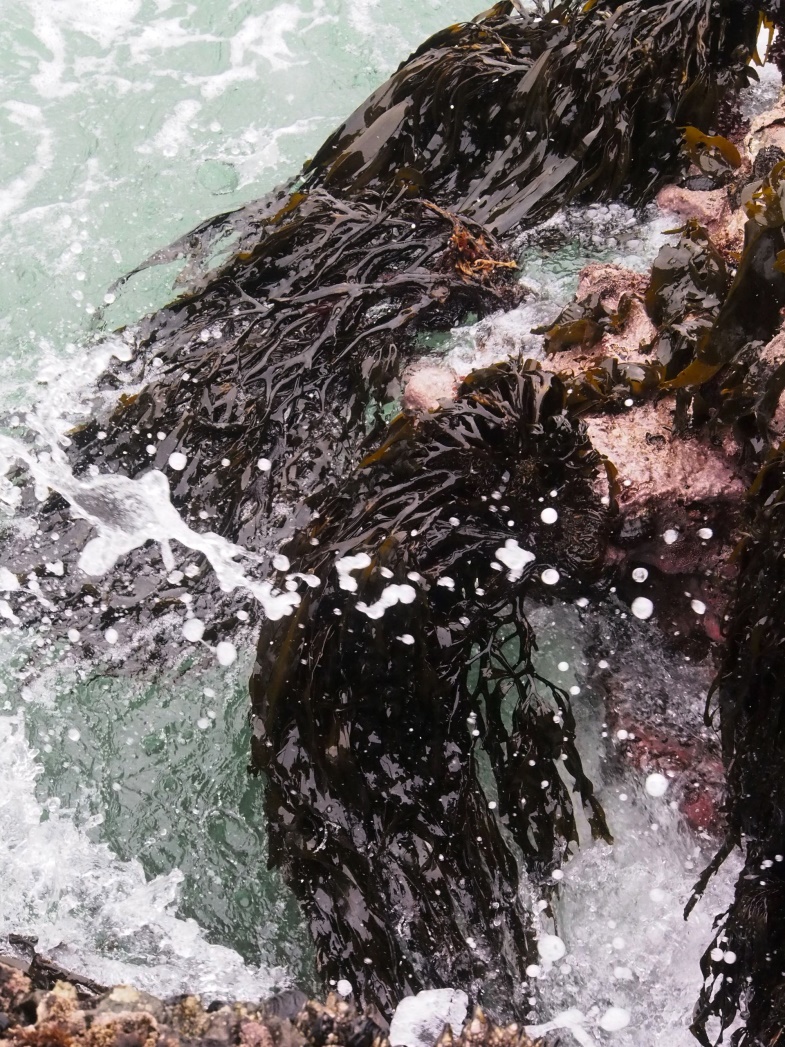
Figure 1 (left) & Figure 2 (right): Lessoniopsis littoralis growing on the edge of a surge channel (the rock here is coated with pink coralline algae). In the figure on the left the branches of the Strap Kelp are hanging in midair above the ocean; in the figure on the right the blades of this kelp are lifted and freshly immersed by the active ocean swell. Botany Bay, Strait of Juan de Fuca, B.C., Canada. May 17, 2022. Photo ID: 27205 ©Seaweedwhisperings.com & Photo ID: 27206 ©Seaweedwhisperings.com
Person 1:
Likes to perch at the edge where all can see it and it can see all around.
Very strong and tough.
Don’t mess with me!
Projects an aura of strength and dominance.
But maybe it’s only dominant in a narrow realm. After all it’s the only one that can THRIVE on vertical surfaces impacted by heavy surf.
Angry and impatient.
Knows its realm and perhaps unsatisfied/unhappy that it can’t grow/expand into other realms.
Its realm is indeed a challenging one. Oddly, it persists and actually thrives – in other words has a stable presence, in these demanding conditions.
It seems very active in protecting its territory, vigorously swishing and swatting back and forth in the surf. Nothing is going to take over these rocks from me!
Protects its own kind but doesn’t really care about their well-being.
The flattened basal branches (stipes) are very tough, not particularly attractive, but give it the strength to persist.
The leafy blades are much more showy, often elegant in their movements as they ride the surf.
As I watched huge breakers pound the Lessoniopsis-clad rocks, I got the sense that they love the ride… Waving playfully in all directions under the impact of a wave, then letting the blades run down the vertical rock surfaces, mimicking the waterfall movement of the receding ocean water.
On rare days (lowest of tides) some of them come to rest and relax ashore. They seem to be content to rest and enjoy the temporary calm.
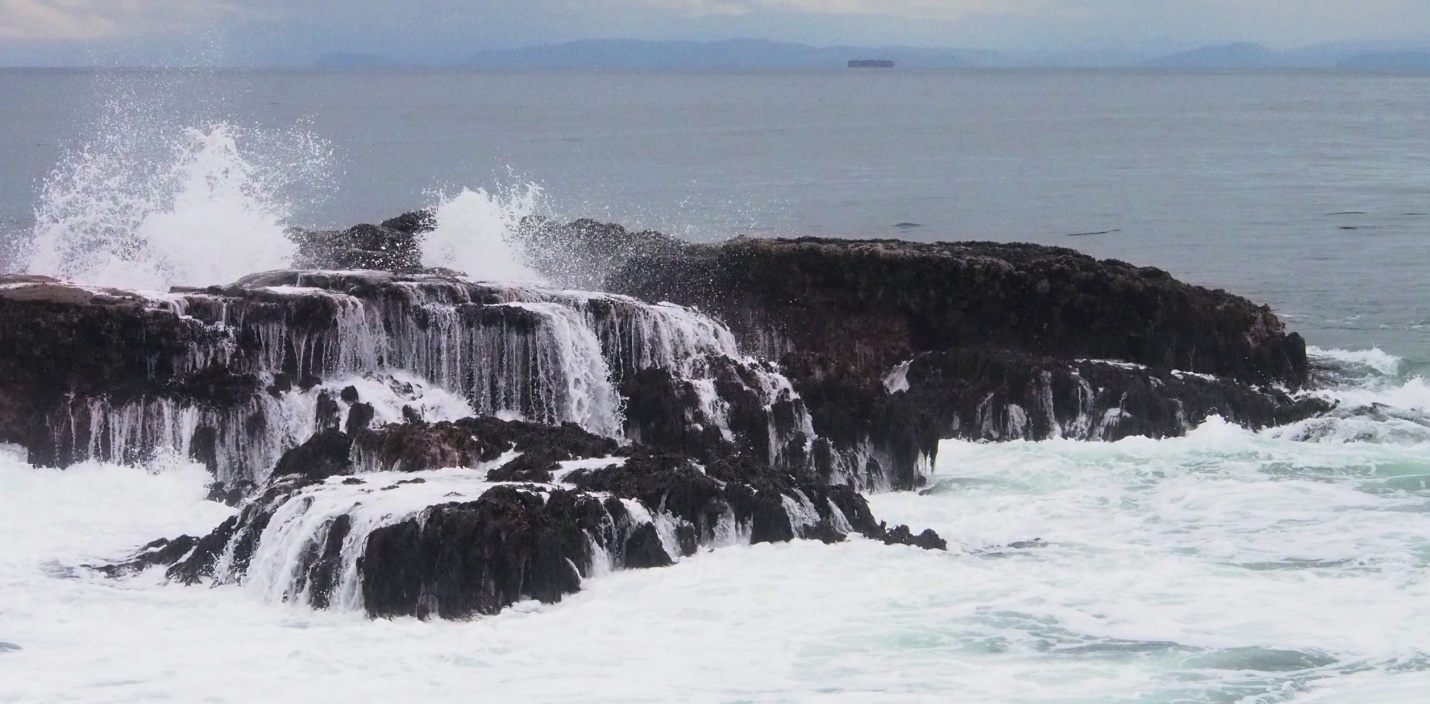
Figure 3: Lessoniopsis littoralis – waterfall of sea and algae. Botany Bay, Strait of Juan de Fuca, B.C., Canada. May 17, 2022. Photo ID: 27207 ©Seaweedwhisperings.com
Person 2:
LOVER of surf!!
You are in Strap Kelp “Heaven” here at this location.
We can find you in several locations but where you predominate is in surge channels and on rock faces exposed to the open Pacific. Places where the incoming ocean swells are concentrated, by rock walls and subtidal reefs, and where surf crashes powerfully and will reach your blades.
I tried it, or almost…, standing on a rock bluff near where you are growing in profusion. The feeling was strong and clear of being “just about to” fall, of being “at the point of” losing hold and free-falling down, down, down…, how far, and to what fate?
When I look at your structure I think I see this distinction expressed there, too – holding on with a strong anchored base and free falling blades that move wildly below in a kind of free fall.
The stipe of Strap Kelp is distinctive; it is irregularly branched, and those branches are somewhat flattened, thick and tough. It looks like an old growth, seasoned-with-age-and-experience, “trunk” of a seaweed version of a “tree”.
When I observed this stipe base in the field I thought of it as being ‘skeletal’. Now as I write out these notes the part of the mammalian skeleton that comes to mind is the ribs. Like massive and strong ribs of whales. Like the creation myth of woman being made from the rib of man. Like ‘ribs’ are somehow fundamental – they protect the lungs and the heart. I think of breath and the life spirit in relationship to the lungs – things more of “the air”. And I think of blood and circulation and steady supportive physicality with the heart – things more of “the physical”. Is this that dichotomy again, anchored well or falling freely in mid-air? Air and earth?
Attached to the strong branched stipe of this perennial seaweed are the numerous blades. They are long and narrow, they have a distinct midrib and the margins of the blades are gently ruffled all along both sides. It is this part of Strap Kelp that enjoys the ‘free fall’ aspect. In many individuals growing here at Botany Bay, the blades hang down, suspended in mid-air, dangling there, ready to be lifted, buoyed, refreshed and nourished by the next ocean swell.
On some of the rock islets here Lessoniopsis littoralis completely rims them and when the Pacific swells surge up and over and crash on these islets what results is a WATERFALL of white roiling surf and dark quivering and shimmering blades of strap kelp. The rocks become a waterfall of seawater and algae that is something to behold. I would say what I see in that is a portrayal of the merging of equals.
Yes, only those Strap Kelp individuals that are equal to this kind of wave action can be a part of this.
It is awesome – a powerful dance of two. Dark and light. Liquid and solid. Water and algae. Yes, some kind of peak duet – a moving, dynamic, merging of opposite equals.
When the strap kelp blades are not fully immersed the main thing that caught my attention was the long chains of spots of light that glisten from the side ruffles of the blades. It reminded me of the twisted silver tinsel that my mother loved to adorn the family Christmas tree with – and this tinsel, for her to be happy with it, it had to dangle freely, not touching any other ornament or branches. This is just how Strap Kelp loves to be – dangling freely, hanging in a freefall from the stipe.
So, the free and dangling ends is what allows the best interplay with light – it is what gives movement and the chance to reflect the powerful sunlight in every changing places along the blades.
Writing up these notes was done during a most intense and unusual spring storm. Power was cut off and restored, cut off and restored. It seems to me that this fits with Lessoniopsis littoralis – there is an interaction with POWER that this seaweed craves. In fact, I think it is an interaction with power that this seaweed needs. It will not thrive without that.
And there can be a cost/benefit to this interaction. Lessoniopsis will be stripped down and have ripped away anything that does not serve its purpose specifically and any part of itself that is not currently still strong enough to continue in that service. There’s a natural and perpetual interaction that forces / demands / assists in keeping Strap Kelp in top condition. But nothing else can be held onto for sentimental reasons or any other reason at all, actually. It is an imperative that Strap Kelp is at peak condition – just at the point of falling, but NOT falling – thriving in this most precise, unusual and extreme position.
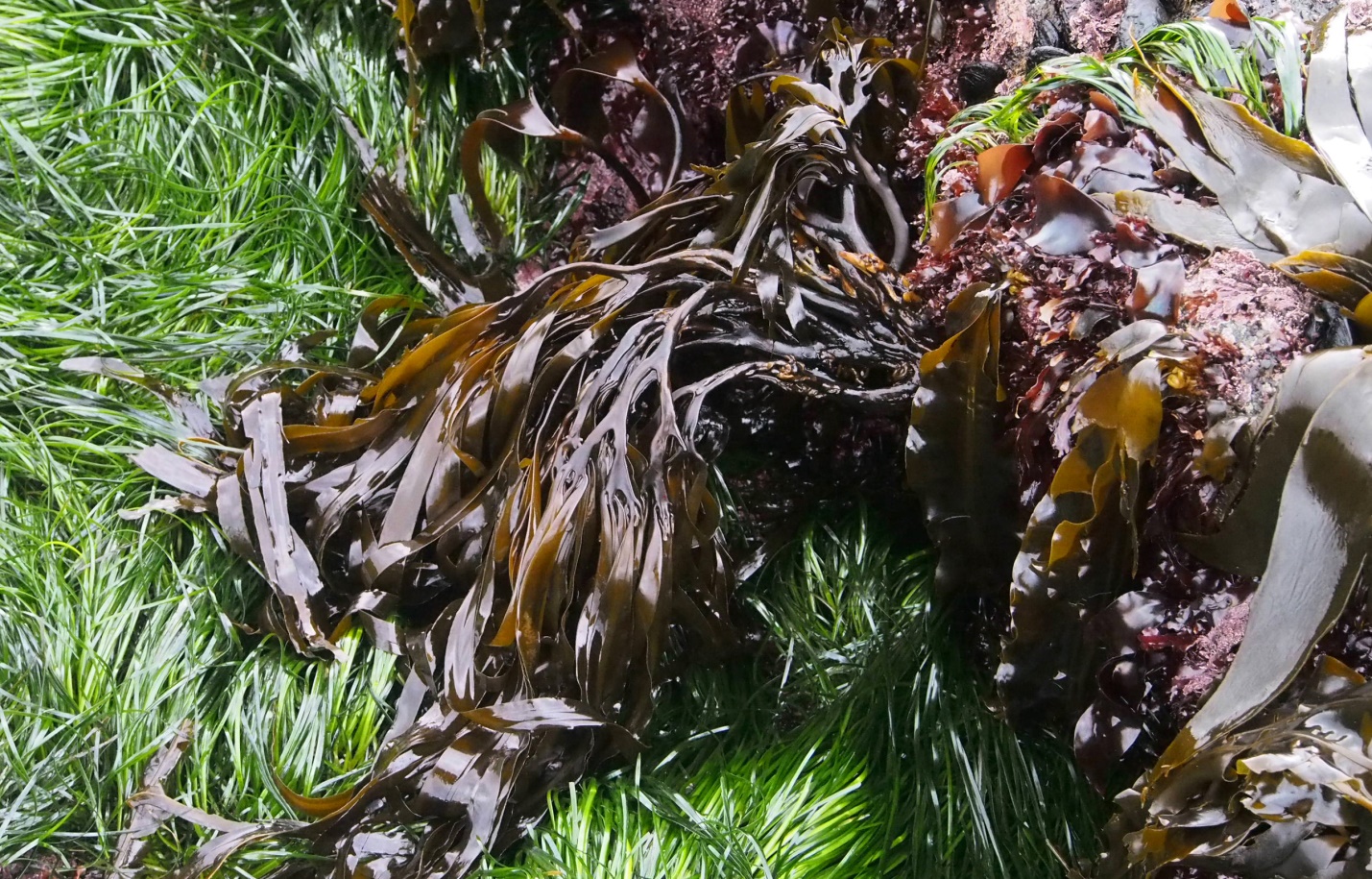
Figure 4: Lessoniopsis littoralis is pictured here in precisely its preferred zone. To know your tide level you simply need to know your kelps! The large olive green blades (on the right edge of the photo) are Sea Cabbage, which Lessoniopsis typically grows below, and a few stems of Southern Stiff-stiped Kelp are visible (at top and center) and this species prefers to grow at tidal depths just a bit lower than Strap Kelp. Botany Bay, Strait of Juan de Fuca, B.C., Canada. May 17, 2022. Photo ID: 27208 ©Seaweedwhisperings.com
Discussion:
What triggers feelings of anger and impatience in Lessoniopsis? It is when you are being challenged and you don’t have an answer for yourself and how you ‘are’ responding in that challenge. It’s difficult to give this answer because to Lessoniopsis this is simply being oneself. It can be a bit startling to Lessoniopsis, rather like they’ve never had to answer to that type of questioning before, and there is annoyance in finding that there are those who would dare (?) to question them.
At times, Lessoniopsis is fine to rest, lie back and enjoy the ‘temporary calm’; why…? It’s all about knowing everything is going as it should. There’s nothing to do.
Littoralis – this species names has a strong resemblance to the English word, ‘literal’. Literal, meaning to the letter; verbatim; taken in the most basic sense without metaphor or allegory. This feels connected to the sense we have of how only the strong and vital can be retained in this living seaweed, there’s no room for ‘nostalgia’ or holding on to parts that are past prime – no, they must go! It is like Strap Kelp has a life that is “taken to its most basic” expression, and this is the only one that survives, let alone thrives.
Only the precise and correct and literal word / action / thought will do, nothing less. There is no room for error or even much experimentation. In fact the feeling is that anything less will certainly be broken away, destroyed by the next testing or lesson delivered. So anything less than ‘literal’ cannot endure and be a part of Lessoniopsis.
Watching the surf crashing against the shore here brought home just how Lessoniopsis littoralis is almost always taking / receiving/ getting “lessons”. Incessantly the surf doles out these lessons.
We wondered, in the Strap Kelp reality, how does this feel?
To be having ‘lessons’ all the time?
One part is clear; the lessons are valuable and needed as they keep Strap Kelp in their prime. Constantly being toned and conditioned and challenged to be in prime condition.
Another aspect came, too, and that is feeling irritated, sometimes even feeling exasperated and angry, to be facing seemingly very similar lessons over and over.
This comes back to what Person 1 said about being dominant but in a narrow realm. The “lessons” Strap Kelp receives keep them fit and prime for this one realm, and this same action results in there being little option for a change of position, a different approach, trying out another or a new way of life. This could be the chief underlying ‘cost’ / regret / limitation in the Lessoniopsis littoralis experience.
The strength of this seaweed was very clear in this Whispering. The question that came up was; is this strength, dominance and anger in fact masking a sense that if the seaweed doesn’t keep fighting against something / anything it will need to consider whether the fight is really necessary?
Does this seaweed like the rest phase or is it merely part of cycle like sleep for a human that is necessary for the next day of survival?
Ultimately we sensed that this seaweed has chosen this lifestyle as being what it wants; it wants to be continually tested but acknowledges that it too does need periods, no matter how brief, when it can rest rather than fight to hang on.
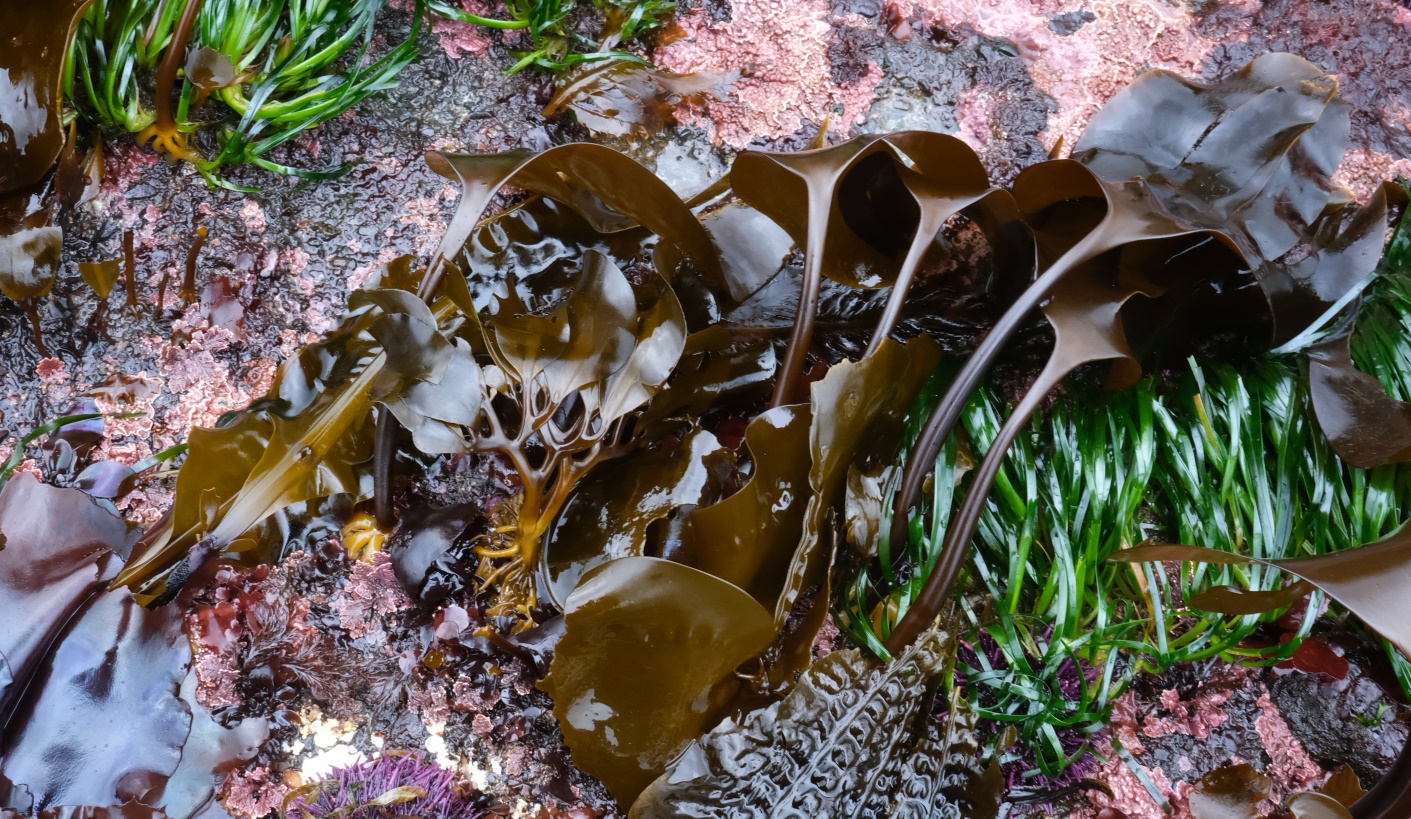
Figure 5: A very young Lessoniopsis littoralis individual is pictured here (slightly left of center with its forking stipe and branched holdfast plainly visible. It is growing next to its usual neighbor, Laminaria setchellii and blades of Costaria costata and Alaria marginata and Mazzaella spendens along with encrusting coralline algae and a bit of surf grass to add to the life diversity here. Botany Bay, Strait of Juan de Fuca, B.C., Canada. May 17, 2022. Photo ID: 27209 ©Seaweedwhisperings.com
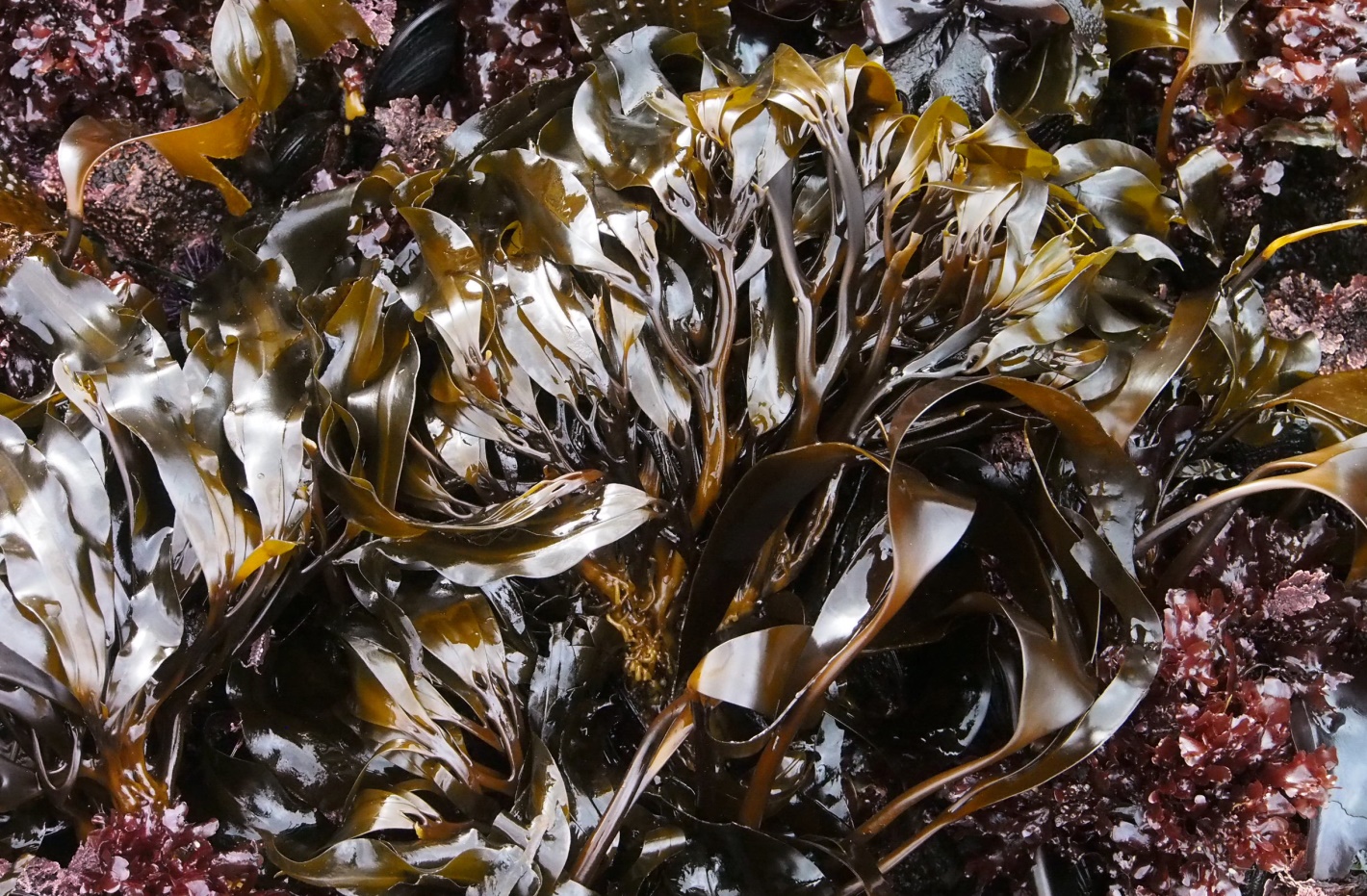
Figure 6: A few older Lessoniopsis littoralis individuals are seen here. Botany Bay, Strait of Juan de Fuca, B.C., Canada. May 17, 2022. Photo ID: 27210 ©Seaweedwhisperings.com
Biology & Natural History Information:
Description:
The thallus of this medium to dark brown kelp has a branched holdfast (haptera) and a trunk-like stipe that is profusely dichotomously branched. The conical holdfast of a mature Strap Kelp is very tough and woody and can be very large, 20 cm in diameter and 40 cm long. From the holdfast thick Y-shaped branches arise and they branch several times again in close succession; from the end of each of these branches narrow, strap-like blades with flattened midribs grow. The blades can reach 2 meters in length and in older individuals there can be up to 300 to 500 blades. Reproductive sporophylls are located near the base of older blades.
Habitat:
This perennial brown alga is found on rock in the very low intertidal to shallow subtidal in exposed habitats with strong surf action. It usually occupies a narrow zone of the intertidal region that is below Saccharina sessilis (Sea Cabbage) and above Laminaria setchellii (Southern Stiff-stiped Kelp).
North Pacific Distribution:
Kodiak archipelago, Alaska to Monterey, California.
Remarks:
Lessoniopsis littoralis is the type species (holotype) of the genus Lessoniopsis. The species name is derived from the Latin (adjective) “pertaining to the shore”. The littoral zone is the part of a sea, lake or river that is close to the shore. On the seashore, this ecological zone is dynamic and includes the region from the high tide mark (which experiences the effects of breaking waves, tidal and longshore currents) and on down to the shoreline areas that are below tide level to a depth of 5 to 10 meters (depending on the intensity of storm waves). The genus, Lessoniopsis, is named for Lesson, a German phycologist.
Classification:
Phylum: Ochrophyta
Class: Phaeophyceae
Order: Laminariales
Family: Alariaceae
Genus: Lessoniopsis
Species: Lessoniopsis littoralis (Farlow & Setchell ex Tilden) Reinke 1903
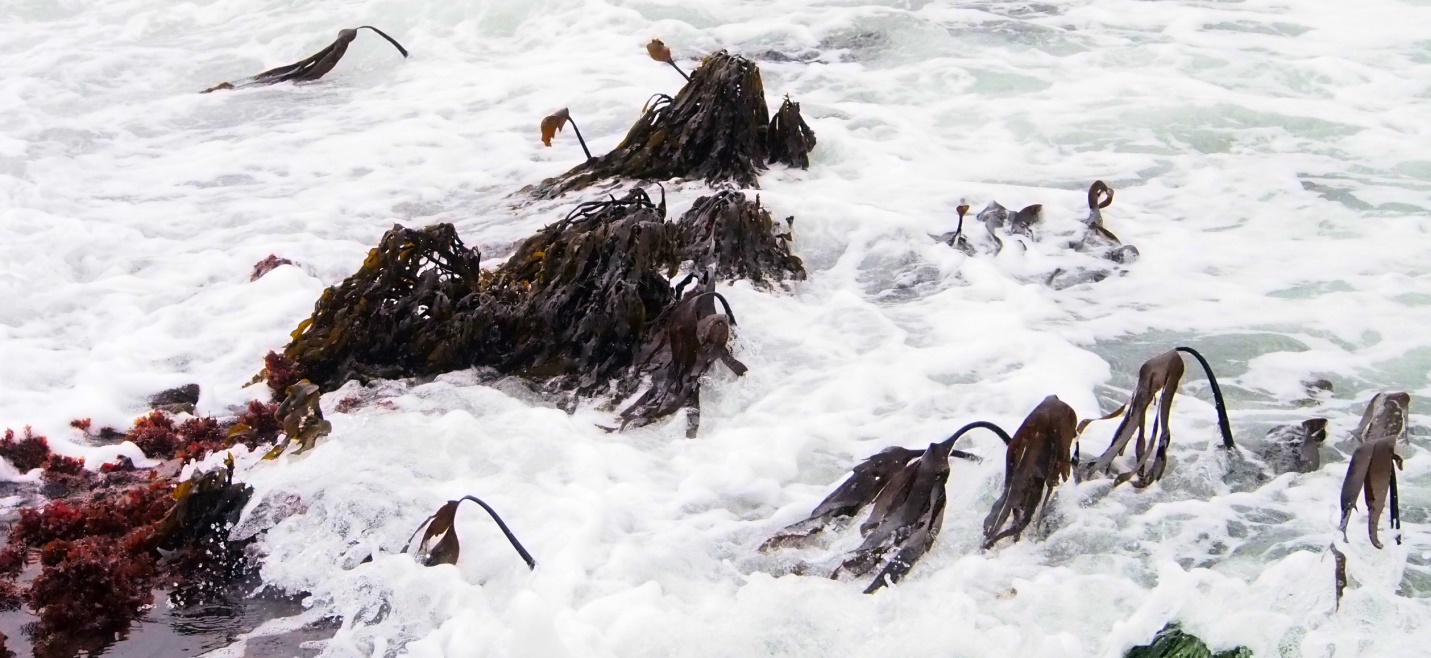
Figure 7: The surf washes into shore and both species of kelp growing here, Strap and Southern Stiff-stiped, relish in the fact! Botany Bay, Strait of Juan de Fuca, B.C., Canada. May 17, 2022. Photo ID: 27211 ©Seaweedwhisperings.com
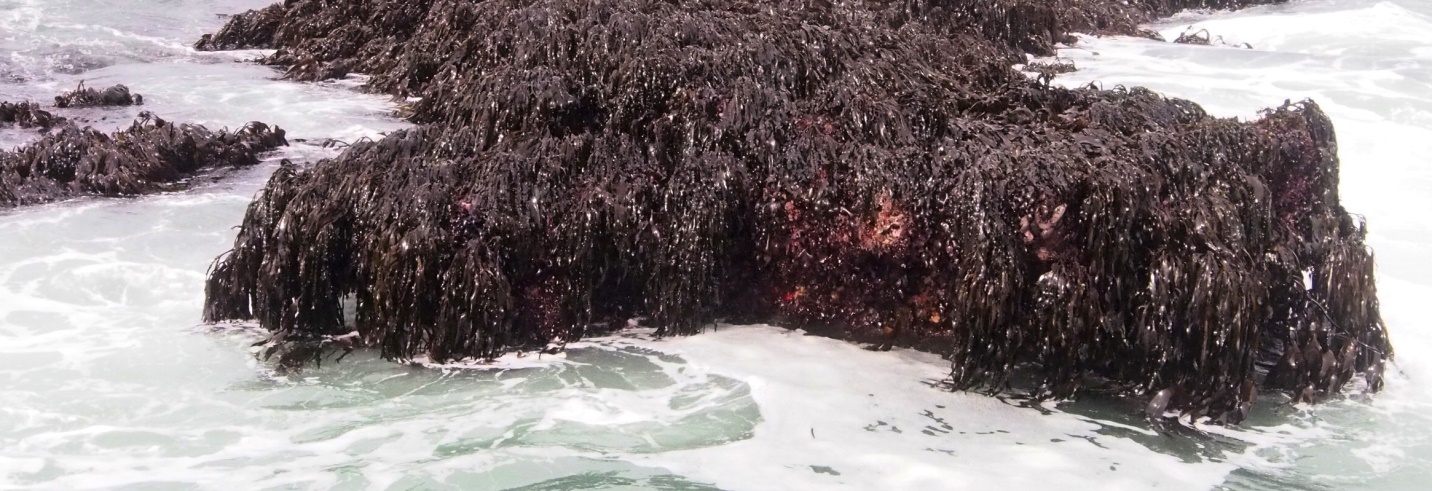
Figure 8: An offshore islet makes a perfect home for Lessoniopsis littoralis; pictured here, in the calm between ocean swells, the numerous blades drape down to the Pacific waters and await their next interaction. Botany Bay, Strait of Juan de Fuca, B.C., Canada. May 17, 2022. Photo ID: 27212 ©Seaweedwhisperings.com
![]()